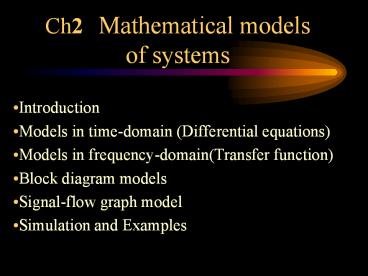Ch2 Mathematical models of systems - PowerPoint PPT Presentation
1 / 22
Title:
Ch2 Mathematical models of systems
Description:
Ch2 Mathematical models of systems Introduction Models in time-domain (Differential equations) Models in frequency-domain(Transfer function) Block diagram models – PowerPoint PPT presentation
Number of Views:78
Avg rating:3.0/5.0
Title: Ch2 Mathematical models of systems
1
Ch2 Mathematical models of systems
- Introduction
- Models in time-domain (Differential equations)
- Models in frequency-domain(Transfer function)
- Block diagram models
- Signal-flow graph model
- Simulation and Examples
2
2.1 Introduction
Mathematical models can help us to understand and
control complex system effectively. So it is
necessary to analyze the relationships between
the system variables and to obtain a
mathematical model. Because the systems are
dynamic in nature, the descriptive equations are
usually differential equations, if they can be
linearized, then Laplace transform can be used to
simplify the method of solution.
3
Modeling method
Goals of modeling
- Analysis
- Design or Control
- Analytical method
- Experimental method
4
Models under Consideration
- Linear
- Time-invariant (constant)
- Parameter-lumped
5
2.2 Differential equations of physical systems
- Through-variable and across-variable
- Analogous variables
Refer to (P34-37)
Voltage-Velocity analogy Force-current analogy
6
How to obtain DE ?
- Newtons laws for Mechanical system
- Kirchhoffs laws for electrical systems
- Two examples
(Refer to script 2-2)
7
Solving the equation
- Analytical or classical method
- Laplace transform method
- Example of solving differential equation
( Refer to script 2-3,4)
8
Modes of dynamic system
- Modes is determined by Characteristic roots
- real and distinct roots
- real and repeated roots
- complex conjugate roots
9
2.3 Linear approximations of physical systems
- Non-linearity is essential and pervasive
- A system is defined as linear in terms of the
- system excitation and response.
- Principle of superposition
- Homogeneity
- A linear system satisfies the properties of
superposition and homogeneity
10
Linear approximations method
- Taylor series expansion
- Example pendulum oscillator model
Refer to P40
11
2.4 The Laplace transform
- Review complex algebraic (refer to P41-47)
- Laplace transform
- Inverse Laplace transform
- residue evaluation
- Final value theorem
12
Time response by Laplace transform
- Time response solution is obtained by
- 1. obtain the differential equations
- 2. obtain the Laplace transformation of
- differential equations
- 3. solve the algebraic equation of the
- variable of interest
- 4. obtain the response by the inverse
- Laplace transform
13
2.5 The transfer function of linear system
- Transfer function is defined as the ratio of the
Laplace transform of the output variable to the
laplace transform of the input variable , with
all initial conditions assumed to be zero. - Examples (refer to P48)
14
Characteristics of TF (???????)
- Black-box model
- rational real fractional function
- transition between TF and DE
- TF and impulse response
Transfer function is the Laplace transform of the
impulse response and vice versa.
15
Implication of TF(???????)
- Zero initial condition
- representation of poles and zeros
Inputs and outputs of system are zero at t0-
16
TF of typical elements and dynamic systems
- Basic factors of TF
- Examples of TF
Refer to P50-57 and Table 2.5
(P58-61)
17
2.6 Block diagram models(?????????)
- Block diagrams representation is prevalent in
control engineering, and consist of
unidirectional operational blocks that represent
the transfer function of the variables of
interests. - Representation of block diagram
Refer to P62-63
18
Transformation of Block Diagram
- BDSchemeEquation
- Four Components of BD (refer to 2-14,15)
- Transition between TF and BD
Refer to 2-15,16,17
19
Characteristics of BD
- Unidirectional Principle
- Without load effect
- Connection ways
Series parallel and feedback connection
20
Block diagram reduction
- Combination of blocks in cascade
- Combination of blocks in parallel
- Elimination of feedback loop
- Moving pickoff points and summing points
Principle Keep every signal to be equivalent
21
Examples of BD reduction
- Refer to textbook ( P64-66)
- Other examples refer to (2-19,20,21)
22
Assignment(????)
- Review Ch2 (P32--)
- E2.4
- E2.6
- E2.8
- E2.18































